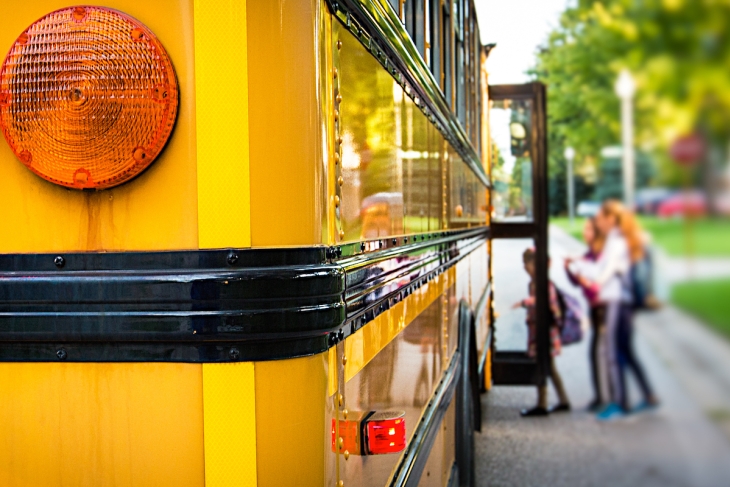School transportation problems have been big news across the country in the last few years. Pandemic-era challenges are often blamed, but a recent report—looking qualitatively at the state of play in three very different state/district contexts—shows that the Gordian Knot of requirements and difficulties is not new at all.
Carolyn Sattin-Bajaj—an analyst in the Urban Institute’s Student Transportation Working Group and an associate professor at the University of California, Santa Barbara—dives into the issues surrounding student transportation at a time when school choice is growing. She interviews numerous district administrators, charter school leaders, charter authorizers, and stakeholders, including advocacy organizations and local foundations, in three choice-rich school districts with varying transportation policies: Detroit, New York City, and New Orleans. Choice supporters are clear that publicly-funded transportation is a cornerstone of the effort to facilitate student access to higher-quality school options. And while each jurisdiction addresses transportation and choice differently, some common issues recur.
But first, let’s summarize the key transportation policies in each. In New York City, the state department of education oversees transportation for all students, including those attending charters. Yellow buses are available for kids in grades K–6 depending on their distance in miles from home to school. Students in grade seven and above are provided Metro cards for use on public buses and subways, also based on their home-to-school distance. If kids don’t qualify for the yellow bus or full fare metro cards, they may be eligible for half-fare metro cards.
In Detroit, only those students attending district schools are guaranteed transportation. If they are enrolled in a charter or in a neighboring district through participation in Michigan’s Schools of Choice program, receipt of transportation services is at the discretion of the school or district and paid by the school, charter management organization, or district (although students with disabilities who qualify for special bus service receive individualized transportation). Detroit also has very limited public transportation infrastructure, which restricts its ability to support students.
Finally, in charter-centric New Orleans, state law requires public districts—which includes charters as their own local education agencies (LEAs)—to provide transportation for students living farther than one mile from school. In many cases, this means that charters operate and pay for their own yellow buses.
Leaders in all three locales say that transportation costs are among their largest budget items, with transport for special needs children especially high. For instance, in New York City in 2016–17, special needs students comprised 13 percent of the total population but accounted for 75 percent of the transportation budget.
The interviewed district and charter leaders report trying eight key strategies (most of which have problematic tradeoffs) to either offer more services or reduce the escalating cost of existing transportation services. They include: 1) contracting with the district for yellow buses, a strategy that charters in some states can employ, but which often leaves them at the mercy of the district’s bell schedule; 2) negotiating their own contracts, although those can be pricey—especially for smaller or far-flung schools and districts; 3) purchasing a small fleet of buses that then require costly upkeep, inspection, and maintenance; 4) making financial trade-offs, such as not providing buses in order to pay teachers more, or providing buses to ensure sufficient enrollment to stay open but compromising on teacher pay; 5) tiering, which means using the same bus to pick up students on different routes by staggering the arrival times, whereby some kids might get to school at 7:30 and others at 8:30; 6) cutting or consolidating the number of bus routes, which necessitates increased student time on the bus; 7) rebidding bus contracts to try to get a lower cost provider; and 8) setting administrator pay low and/or operating a lean central office.
These less-than-ideal solutions are made more complicated by other issues. For instance, in choice-rich districts with high student mobility, current routes are routinely impacted, even as just-arrived parents make requests for new routes. Parents also register complaints about safety on the bus, especially when students are leaving or returning home in the dark. Misbehavior often worsens when districts are either not able to afford hiring bus attendants or students travel on crowded buses due to a shortage of drivers.
The report does not delve deeply into detailed solutions or best practices. But one often-neglected solution was mentioned that could incent parents to help out: Some districts are now paying families to make their own arrangements if they have students eligible for school transportation but choose not to use it.
Outside of that, the author encourages more centralization of transportation within and across schools and across school sectors for better negotiated contracts. But the devil is in the details, of course, as the traditional school and charter sectors don’t often play nicely together. What’s more, federal school transportation regulations stipulate the types of vehicles that can be used (for instance, no fifteen-passenger vans) and the qualifications of drivers, which tend to favor large providers like districts over smaller providers like charter schools—no matter how much more economical one choice might be over the other. The list goes on, but it’s not transportation problems that our students need more of. It’s more solutions.
SOURCE: Carolyn Sattin-Bajaj, “Student Transportation in Choice-Rich Districts: Implementation Challenges and Responses,” Education Finance and Policy (April 2022).


